Comparative Life Cycle Impact Assessment between the Productions of Zinc from Conventional Concentrates versus Waelz Oxides Obtained from Slags
Abstract
1. Introduction
- -
- The Millenium Summit from 2000, which established the framework for tackling poverty, hunger, disease, and inequality [4];
- -
- The United Nations Conference for Sustainable Development Rio+ from 2012 where the sustainable development objectives for the following years were established through the document entitled “The Future We Want” [5].
2. Case Study
3. Materials and Methods
3.1. LCA Stages
- (1)
- Goal and scope definition;
- (2)
- Inventory analysis;
- (3)
- Impact assessment;
- (4)
- Interpretation.
3.2. Functional Unit
3.3. System Boundaries
3.4. Selection of LCIA Methodology and Types of Impact Categories
- Climate change;
- Ozone depletion;
- Photochemical ozone formation;
- Acidification;
- Terrestrial eutrophication;
- Freshwater eutrophication;
- Marine eutrophication.
3.5. Interpretation
3.6. Software and Data
- Water—the standard raw water process available in ecoinvent 3 database was used, from unspecified natural origins.
- Natural Gas—average for Romania is 90% domestically produced, 10% import from Russia [41].
- Electricity—being a consequential type LCA, marginal energy has been used instead of a national average, the reasoning being that these types of energy are the ones that can react to an increase of demand in the system. Therefore, based on data from the Romanian National Energy Regulatory Authority [42], the marginal technologies and percentages identified for Romania are presented in Table 1 (reference year: 2018).
- Avoided materials—another important characteristic of consequential LCA is the use of avoided materials instead of allocation. In essence, these are the materials that see a drop in demand as a consequence of a new product or method of production entering the scene. In our case, the alternative used in producing zinc was Waelz oxides, which replaced conventional zinc concentrates—thus avoiding their use. This avoidance is considered in the system as a benefit.
3.7. Assumptions and Limitations
4. Process under Study
5. Results and Discussion
5.1. Sensitivity Analysis
6. Conclusions
- Economically—the slags, which are currently considered as waste, can be reused as raw materials, thus providing a source of monetary gain.
- Ecologically—by using and depleting existing deposits the area will be cleaned up and greened.
- Socially—the whole process of reusing the slag deposits can create jobs for the local community, as well as visually improving the area.
Author Contributions
Funding
Institutional Review Board Statement
Informed Consent Statement
Data Availability Statement
Acknowledgments
Conflicts of Interest
Appendix A
| Impact Category, Unit | Substance | Compartment | Zinc—Conv. | Zinc—Oxide |
|---|---|---|---|---|
| Climate Change, kg CO2 eq, 0.1% cutoff | Carbon dioxide, fossil | Air | 5927.26 | 6892.698 |
| Methane, fossil | Air | 1421.811 | 4499.167 | |
| Carbon dioxide, in air | Raw | 677.9861 | 1938.538 | |
| Dinitrogen monoxide | Air | 254.0204 | −120.472 | |
| Methane, chlorodifluoro-, HCFC-22 | Air | 17.02097 | 58.59386 | |
| Carbon dioxide, biogenic | Air | −631.396 | −2255.55 | |
| Remaining | 14.32626 | −7.52258 | ||
| Ozone depletion, kg CFC-11 eq., 0.1% cutoff | Methane, chlorodifluoro-, HCFC-22 | Air | 0.00047 | 0.001619 |
| Methane, bromotrifluoro-, Halon 1301 | Air | 0.000216 | 4.28 × 10−5 | |
| Methane, bromochlorodifluoro-, Halon 1211 | Air | 0.000212 | 5.74 × 10−5 | |
| Methane, tetrachloro-, CFC-10 | Air | 3.77 × 10−6 | −4.46 × 10−6 | |
| Ethane, 1,2-dichloro-1,1,2,2-tetrafluoro-, CFC-114 | Air | 1.31 × 10−6 | −7.09 × 10−5 | |
| Remaining | −4.21 × 10−7 | −2.54 × 10−6 | ||
| Photochemical ozone formation, kg NMVOC eq., 0.1% cutoff | Nitrogen oxides | Air | 52.70503 | −7.41569 |
| NMVOC, non-methane volatile organic compounds, unspecified origin | Air | 37.03032 | 100.575 | |
| Sulfur dioxide | Air | 4.861291 | 5.138294 | |
| Benzene | Air | 1.132701 | 3.921851 | |
| Methane, fossil | Air | 0.574412 | 1.817664 | |
| Ethane | Air | 0.215049 | 0.594359 | |
| Remaining | 0.209539 | 0.177419 | ||
| Acidification, molc H+ eq., no cutoff | Sulfur dioxide | Air | 78.52393 | 82.99834 |
| Nitrogen oxides | Air | 39.00172 | −5.48761 | |
| Ammonia | Air | 16.65315 | −10.5365 | |
| Sulfur trioxide | Air | 1.84 × 10−6 | −1.30 × 10−6 | |
| Terrestrial eutrophication, molc N eq., no cutoff | Nitrogen oxides | Air | 224.5234 | −31.5908 |
| Ammonia | Air | 74.4429 | −47.1003 | |
| Nitrate | Air | 0.000803 | 0.000314 | |
| Freshwater eutrophication, kg P eq., no cutoff | Phosphate | Water | 16.71529 | −7.98288 |
| Phosphorus | Water | 0.005777 | 0.005295 | |
| Phosphorus | Soil | −0.01481 | −0.04315 | |
| Marine eutrophication, kg N eq., no cutoff | Nitrogen oxides | Air | 20.50226 | −2.8847 |
| Nitrate | Water | 1.831327 | 1.215167 | |
| Ammonia | Air | 0.507315 | −0.32098 | |
| Ammonium, ion | Water | 0.066283 | 0.139714 | |
| Nitrite | Water | 0.000111 | −0.00015 | |
| Nitrate | Air | 7.11 × 10−6 | 2.79 × 10−6 |
| Substance Unit: mPt; 0.01% Cutoff. | Compartment | Zinc—Conv. | Zinc—Oxide |
|---|---|---|---|
| Total of all compartments | 721.2669 | 228.779 | |
| Remaining substances | 0.021265 | −0.04973 | |
| Nitrogen oxides | Air | 260.1558 | −36.6044 |
| Phosphate | Water | 170.3986 | −81.3789 |
| Sulfur dioxide | Air | 100.4734 | 106.1985 |
| Carbon dioxide, fossil | Air | 55.89409 | 64.99817 |
| NMVOC, non−methane volatile organic compounds, unspecified origin | Air | 54.49902 | 148.0202 |
| Ammonia | Air | 51.16626 | −32.3731 |
| Methane, fossil | Air | 14.25307 | 45.1023 |
| Carbon dioxide, in air | Raw | 6.393412 | 18.28043 |
| Nitrate | Water | 4.016265 | 2.664969 |
| Methane, chlorodifluoro−, HCFC−22 | Air | 2.729988 | 9.39785 |
| Dinitrogen monoxide | Air | 2.395414 | −1.13605 |
| Benzene | Air | 1.667042 | 5.771946 |
| Methane, bromotrifluoro−, Halon 1301 | Air | 1.180427 | 0.2343 |
| Methane, bromochlorodifluoro−, Halon 1211 | Air | 1.160682 | 0.313609 |
| Ethane | Air | 0.316497 | 0.874743 |
| Ammonium, ion | Water | 0.145365 | 0.306406 |
| Methane, tetrafluoro−, CFC−14 | Air | 0.069776 | −0.03983 |
| Pentane | Air | 0.062507 | 0.041401 |
| Phosphorus | Water | 0.05889 | 0.053975 |
| Butane | Air | 0.050639 | 0.037194 |
| Sulfur hexafluoride | Air | 0.043549 | 0.03756 |
| Hexane | Air | 0.041532 | 0.040429 |
| Propane | Air | 0.038242 | 0.025741 |
| Toluene | Air | 0.029635 | 0.023875 |
| Acetone | Air | 0.02829 | 0.098243 |
| Ethene | Air | 0.022373 | −0.00436 |
| Methane, tetrachloro−, CFC−10 | Air | 0.02068 | −0.02445 |
| Carbon dioxide, land transformation | Air | 0.013983 | −0.01441 |
| Ethane, hexafluoro−, HFC−116 | Air | 0.009293 | −0.00462 |
| Formaldehyde | Air | 0.008645 | −0.00857 |
| Ethane, 1,2−dichloro−1,1,2,2−tetrafluoro−, CFC−114 | Air | 0.007279 | −0.39473 |
| Phosphorus | Soil | −0.15096 | −0.4399 |
| Carbon dioxide, biogenic | Air | −5.95407 | −21.2699 |
References
- Brundland, G. Report of the World Commission on Environment and Development—Our Common Future; United Nations—Oxford University Press: Oxford, UK, 1987. [Google Scholar]
- United Nations. Rio Declaration on Environment and Development; United Nations: Rio de Janeiro, Brazil, 1992. [Google Scholar]
- United Nations. Agenda 21. In Proceedings of the United Nations Conference on Sustainable Development, Rio de Janeiro, Brazil, 3–14 June 1992. [Google Scholar]
- United Nations. United Nations Millennium Declaration; United Nations: New York, NY, USA, 2000. [Google Scholar]
- United Nations. The Future We Want; United Nations: Rio de Janeiro, Brazil, 2012. [Google Scholar]
- United Nations. Transforming Our World: The 2030 Agenda for Sustainable Development; United Nations: New York, NY, USA, 2015. [Google Scholar]
- European Commission. Communication from the Commission to the European Parliament, the Council, the European Economic and Social Committee and the Committee of the Regions. Next Steps for a Sustainable European Future. European Action for Sustainability; European Commission: Strasbourg, France, 2016. [Google Scholar]
- European Council. EU Response to the 2030 Agenda for Sustainable Development—A Sustainable European Future; Council of the European Union: Brussels, Belgium, 2017. [Google Scholar]
- European Commission. Directive 2010/75/EU of the European Parliament and of the Council of 24 November 2010 on industrial emissions (integrated pollution prevention and control). Off. J. Eur. Union 2010, 334, 2010. [Google Scholar]
- Cusano, G.; Gonzalo, M.; Farrell, F.; Remus, R.; Roudier, S.; Sancho, L. Best Available Techniques (BAT) Reference Document for the Non-Ferrous Metals Industries; European IPPC Bureau—JRC Science for Policy Report: Seville, Spain, 2017. [Google Scholar]
- Porter, F. Zinc Handbook—Properties, Processing, and Use in Design; CRC Press: New York, NY, USA, 1991. [Google Scholar]
- Hageluken, C.; Meskers, C. Chapter: 10. Complex life cycles of precious and special metals. In Linkages of Sustainability; MIT Press: Cambridge, UK, 2010; pp. 163–197. [Google Scholar]
- Eurostat. EU Trade since 1988 by CN8 (DS-016890). 2020. Available online: https://ec.europa.eu/eurostat/web/international-trade-in-goods/data/database (accessed on 18 August 2020).
- European Commission. Closing the Loop—An EU Action Plan for the Circular Economy. 2015. Available online: https://eur-lex.europa.eu/legal-content/EN/TXT/?uri=CELEX:52015DC0614 (accessed on 18 August 2020).
- Havanagi, V.; Arora, S.A.V.; Mathur, S. Waste Materials for construction of roads embankment and pavement layers. Int. J. Environ. Eng. Resour. 2012, 1, 51–59. [Google Scholar]
- Prasad, P.; Ramana, G. Imperial smelting furnace (zinc) slag as a structural fill in reinforced soil structures. Geotext. Geomembr. 2016, 44, 406–428. [Google Scholar] [CrossRef]
- Vegas, I.; Ibañez, J.; José, J.S.; Urzelai, A. Construction demolition wastes, Waelz slag and MSWI bottom ash: A comparative technical analysis as material for road construction. Waste Manag. 2008, 28, 565–574. [Google Scholar] [CrossRef] [PubMed]
- Quijornaa, N.; Coza, A.; Andresa, A.; Cheeseman, C. Recycling of Waelz slag and waste foundry sand in red clay bricks. Resour. Conserv. Recycl. 2012, 65, 1–10. [Google Scholar] [CrossRef]
- Quijorna, N.; Miguel, G.S.; Andrés, A. Incorporation of Waelz slag into commercial ceramic bricks: A practical example of industrial ecology. Ind. Eng. Chem. Res. 2011, 50, 5806–5814. [Google Scholar] [CrossRef]
- Sorlini, S.; Collivignarelli, M.; Plizzari, G.; Foglie, M. Reuse of Waelz Slag as Recycled Aggregate for Structural Concrete; RILEM: Bagneux, France, 2004. [Google Scholar]
- Abba, A.; Sorlini, S.; Collivignarelli, M. Research experiences on the reuse of industrial waste for concrete production. In Proceedings of the MATEC Web Conference, Sibiu, Romania, 7–9 August 2017. [Google Scholar]
- Euroslag. Statistics 2016. 2016. Available online: https://www.euroslag.com/wp-content/uploads/2019/01/Statistics-2016.pdf (accessed on 18 October 2020).
- Romanian National Environmental Protection Agency. Report about the state of the environment for the year 2011. In Autoritatea Națională Pentru Protecția Mediului; Raportul Privind Starea Mediului Pentru Anul 2011: Bucharest, Romanian, 2012. [Google Scholar]
- Genderen, E.V.; Wildnauer, M.; Santero, N.; Sidi, N. A global life cycle 474 assessment for primary zinc production. Int. J. Life Cycle Assess. 2016, 2, 1580–1593. [Google Scholar] [CrossRef]
- Werder, M.; Steinfeld, A. Life cycle assessment of the conventional and solar 477 thermal production of zinc and synthesis gas. Energy 2000, 25, 395–409. [Google Scholar] [CrossRef]
- Yadav, D.; Banerjee, R. A comparative life cycle energy and carbon emission analysis of the solar carbothermal and hydrometallurgy routes for zinc production. Appl. Energy 2018, 229, 577–602. [Google Scholar] [CrossRef]
- Felder, R.; Meier, A. Well-to-wheel analysis of solar hydrogen production and utilization for passenger car transportation. J. Solar Energy Eng. 2008, 130, 1–10. [Google Scholar] [CrossRef]
- S.C. OCON ECORISC S.R.L. Report regarding the impact on the environment—Increasing the processing capacity using Waelz technology of the sub-products and products containing zinv and lead on the industrial site of SC Sometra SA in two stages, during the period of 2015–2017. In Raport Privind Impactul Asupra Mediului—Mărirea Capacităţii de Prelucrare Prin Tehnologia Waelz a Subproduselor şi Deşeurilor cu Conţinut de Zinc şi Plumb pe Platforma Industrială S.C. SOMETRA S.A., în Două Etape, în Perioada 2015–2017; S.C. OCON ECORISC S.R.L: Turda, Romanian, 2015. [Google Scholar]
- Hauschild, M.J.; Hijbregts, M.A.J. Life Cycle Impact Assessment; Springer: Dordrecht, The Netherlands, 2015. [Google Scholar]
- Weidema, B.; Bauer, C.; Hischier, R.; Mutel, C.; Nemecek, T.; Reinhard, J.; Vadenbo, C.O.; Wernet, G. Overview and methodology. In Data Quality Guideline for the Ecoinvent Database Version 3; Ecoinvent Report No. 1(v3); The Ecoinvent Centre: St. Gallen, Switzerland, 2013. [Google Scholar]
- Weidema, B. Has ISO 14040/44 Failed Its Role as a Standard for Life Cycle Assessment? J. Ind. Ecol. 2014, 18, 1–3. [Google Scholar] [CrossRef]
- ISO, ISO 14040. Environmental Management—Life Cycle Assessment—Principles and Framework; International Standards Organisation: Geneva, Switzerland, 2006. [Google Scholar]
- ISO, ISO 14044. Environmental Management—Life Cycle Assessment—Requirements and Guidelines; International Standards Organisation: Geneva, Switzerland, 2006. [Google Scholar]
- Jolliet, O.; Saade-Sbeih, M.; Shaked, S.; Jolliet, A.; Crettaz, P. Environmental Life Cycle Assessment; CRC Press: Boca Raton, FL, USA, 2016. [Google Scholar]
- Hauschild, M.; Rosenbaum, R.; Olsen, S. (Eds.) Life Cycle Assessment—Theory and Practice; Springer International Publishing AG: Charm, Switzerland, 2018. [Google Scholar]
- Santero, N.; Hendry, J. Harmonization of LCA methodologies for the metal and mining industry. Int. J. Life Cycle Assess. 2016, 21, 1543–1553. [Google Scholar] [CrossRef]
- Hauschild, M.; Goedkoop, M.; Guinee, J.H.R.; Huijbregts, M.; Jolliet, O.; Margni, M.; de Schryver, A. Recommendations for Life Cycle Impact Assessment in the European Context—Based on Existing Environmental Impact Assessment Models and Factors (International Reference Life Cycle Data System—ILCD Handbook); Publications Office of the European Union, ILCD Handbook: Luxembourg, 2011. [Google Scholar]
- Quijorna, N.; de Pedro, M.; Romero, C.; Andrés, A. Characterisation of the sintering behaviour of Waelz slag from electric arc furnace (EAF) dust recycling for use in the clay ceramics industry. J. Environ. Manag. 2014, 132, 278–286. [Google Scholar] [CrossRef] [PubMed]
- Barna, R.; Bae, H.-R.; Mehu, J.; van der Sloot, H.; Moszkowicz, P.; Desnoyers, C. Assessment of chemical sensitivity of Waelz slag. Waste Manag. 2000, 20, 115–124. [Google Scholar] [CrossRef]
- Pasetto, M.; Baldo, N. Mix design and performance analysis of asphalt concretes with electric arc furnace slag. Constr. Build. Mater. 2011, 25, 3458–3468. [Google Scholar] [CrossRef]
- Romanian National Energy Regulatory Authority. Report Regarding the Monitoring Results of the Natural Gas Market in September 2018. (In Romanian Language: Raport Privind Rezultatele Monitorizarii Pietei de Gaze Naturale in Luna Septembrie 2018); Autoritatea Nationala de Reglementare in Domeniul Energiei: Bucuresti, Romania, 2018.
- Romanian National Energy Regulatory Authority. Report regarding the monitoring results of the electricity market in September 2018; In Romanian language: Raport Privind Rezultatele Monitorizarii Pietei de Electricitate in Luna Septembrie 2018; Autoritatea Nationala de Reglementare in Domeniul Energiei: Bucuresti, Romania, 2018.
- Hilbrans, H.; Hinrichs, W. Stoffmengenflüsse und Energiebedarf bei der Gewinnung Ausgewählter Mineralischer Rohstoffe; Schweizerbart Science Publishers: Hannover, Germany, 1999. [Google Scholar]
- Ayres, R.; Ayres, L. The Life Cycle of Copper, its Co-Products and Byproducts. Eco-Effic. Ind. Sci. 2002, 13, 1–210. [Google Scholar]
- Qi, C.; Ye, L.; Ma, X.; Yang, D.; Hong, J. Life cycle assessment of the hydrometallurgical zinc production chain in China. J. Clean. Prod. 2017, 156, 451–458. [Google Scholar] [CrossRef]

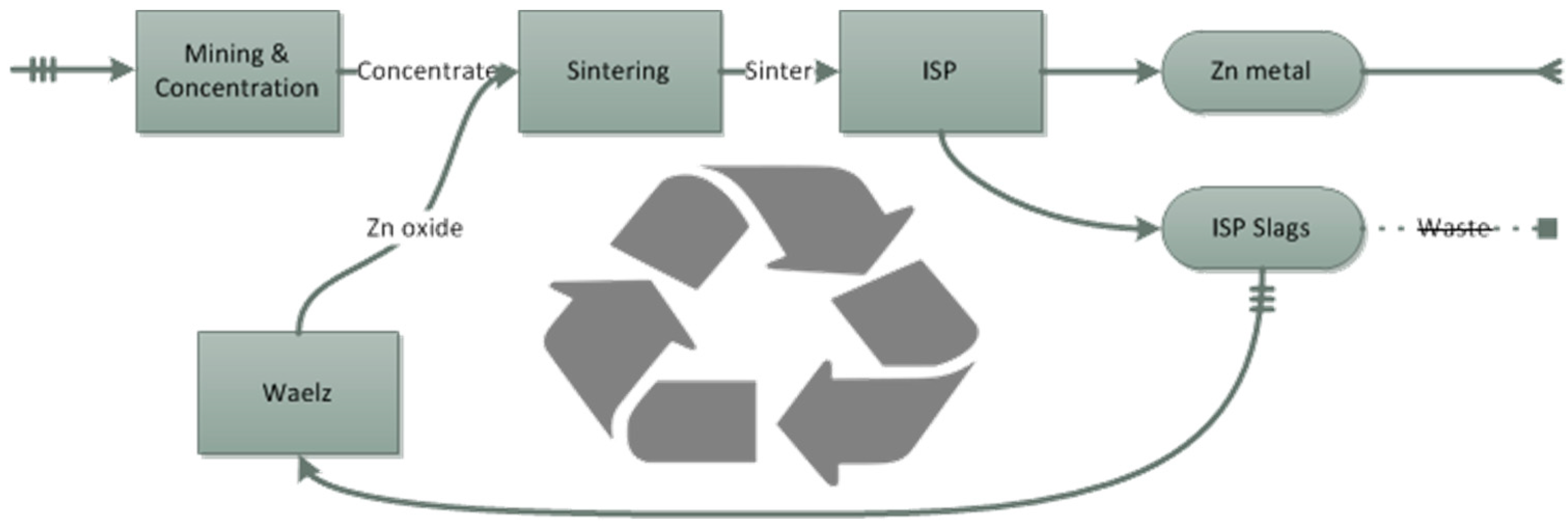


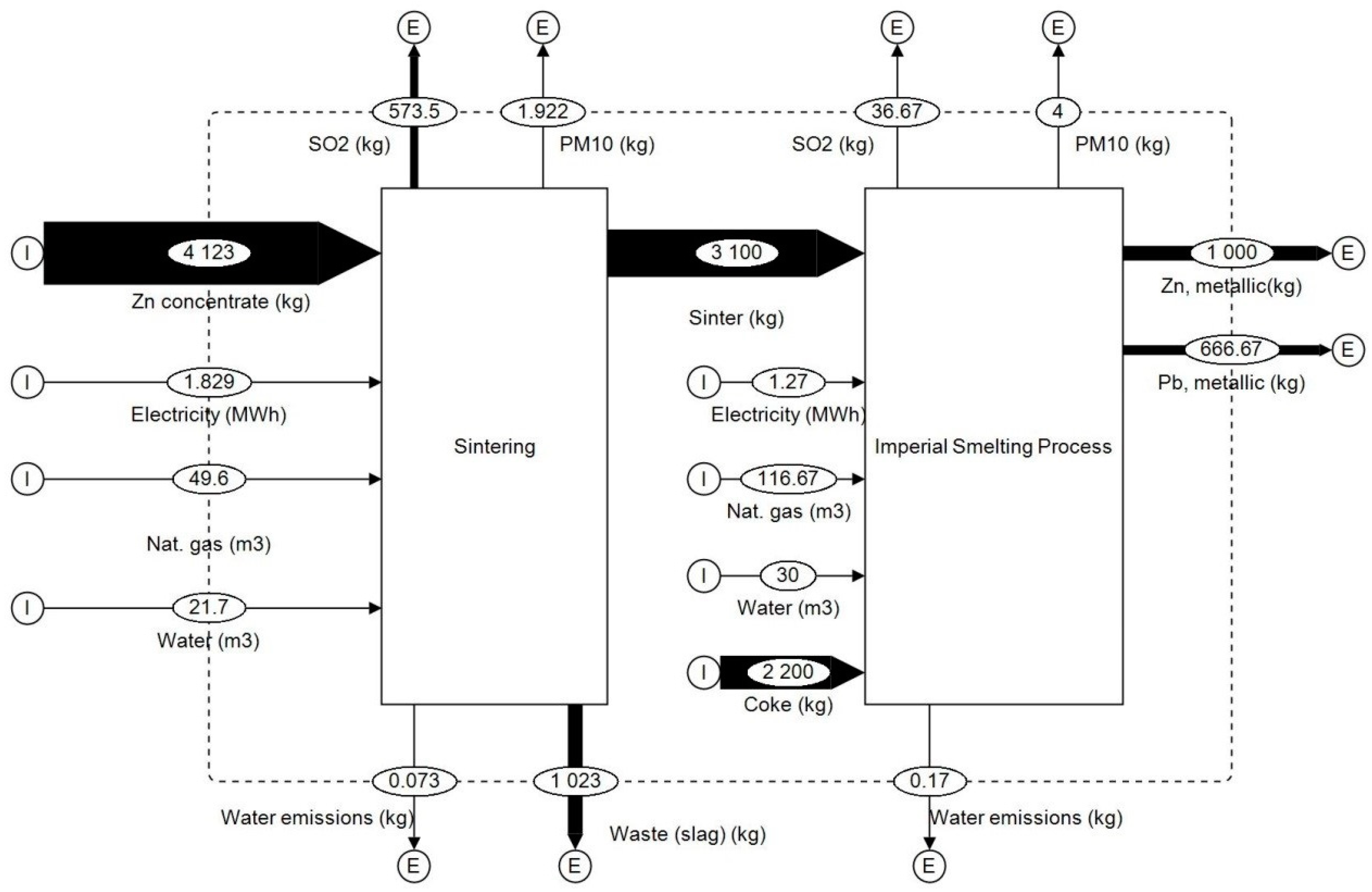
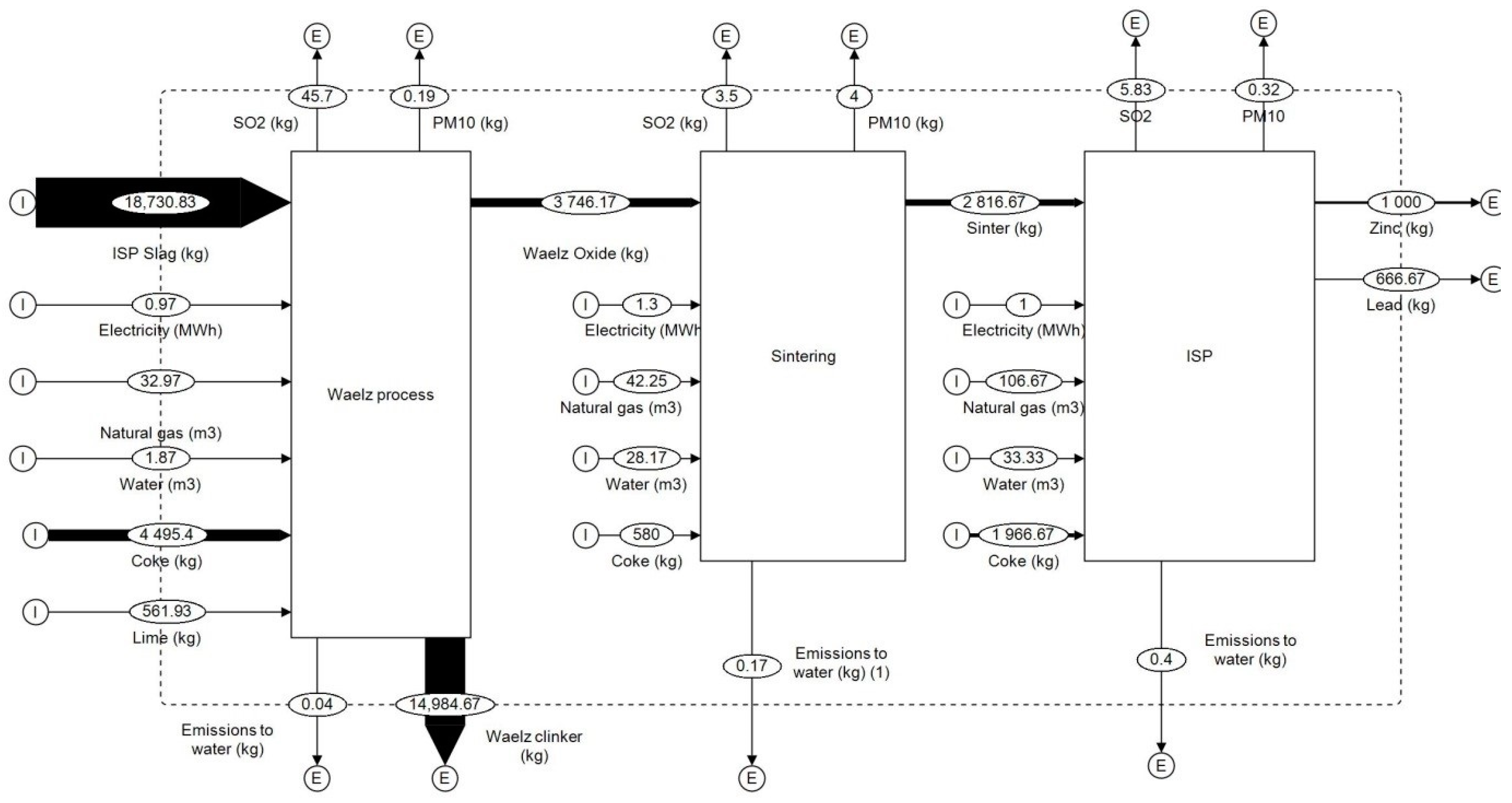
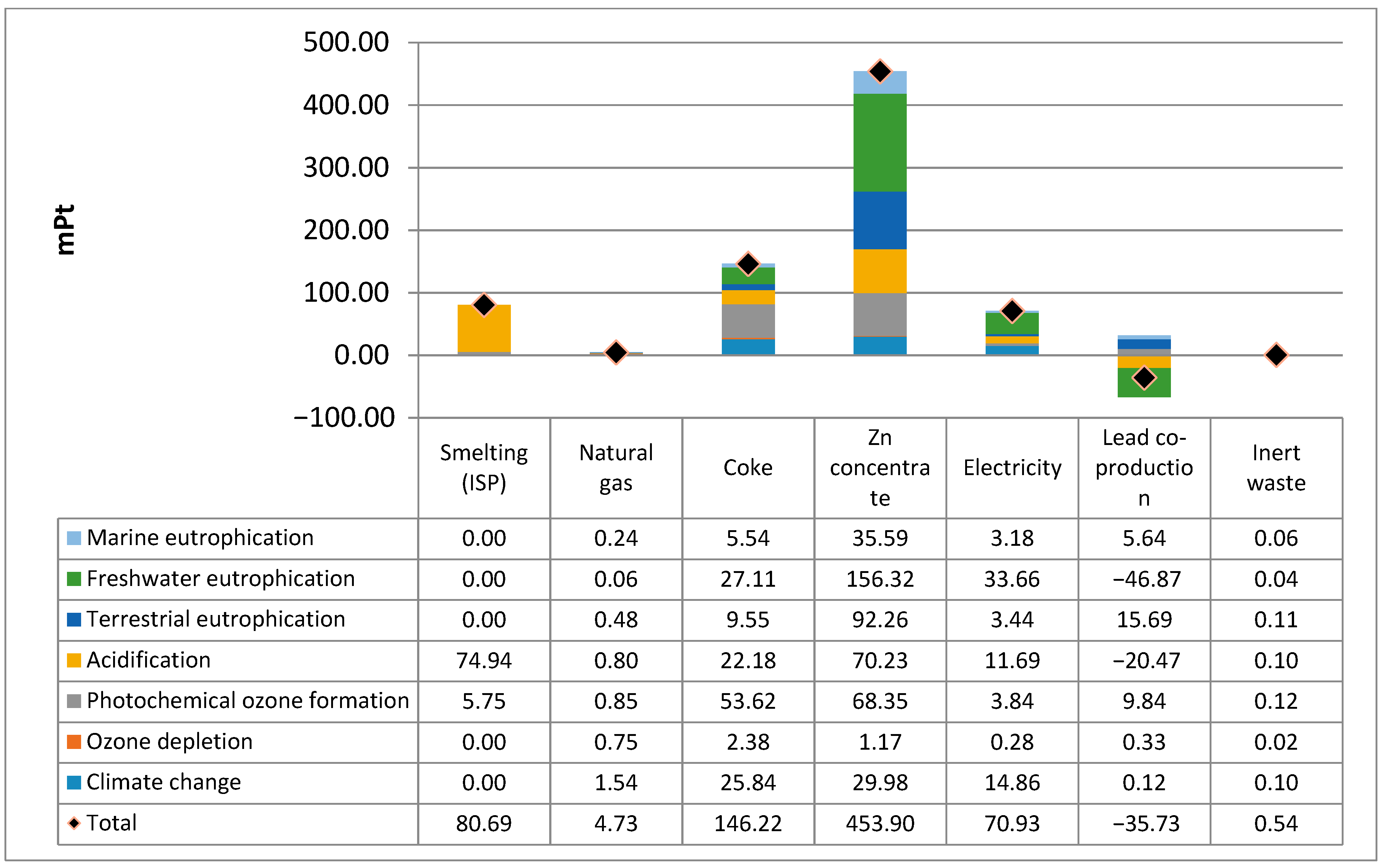


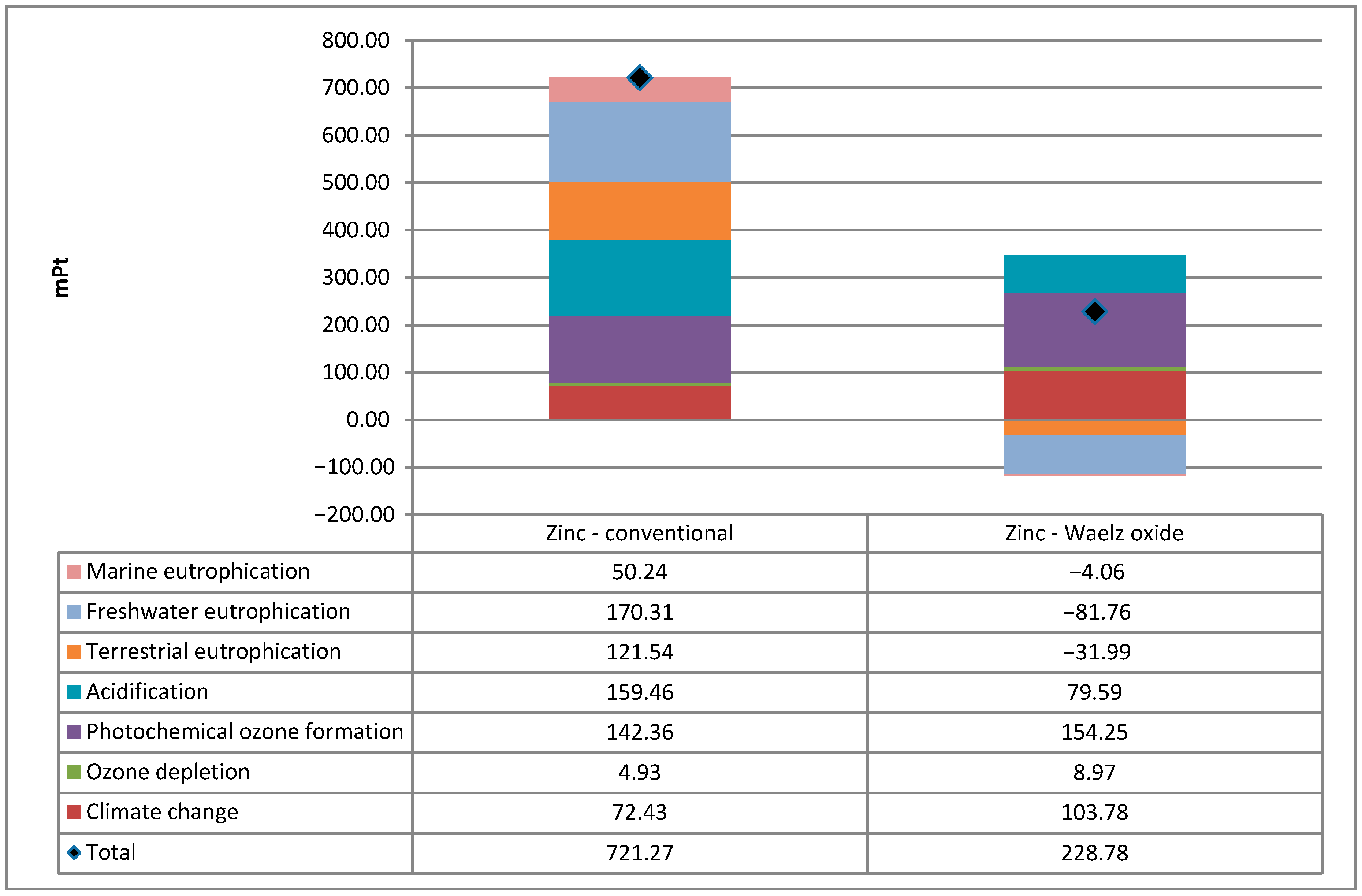
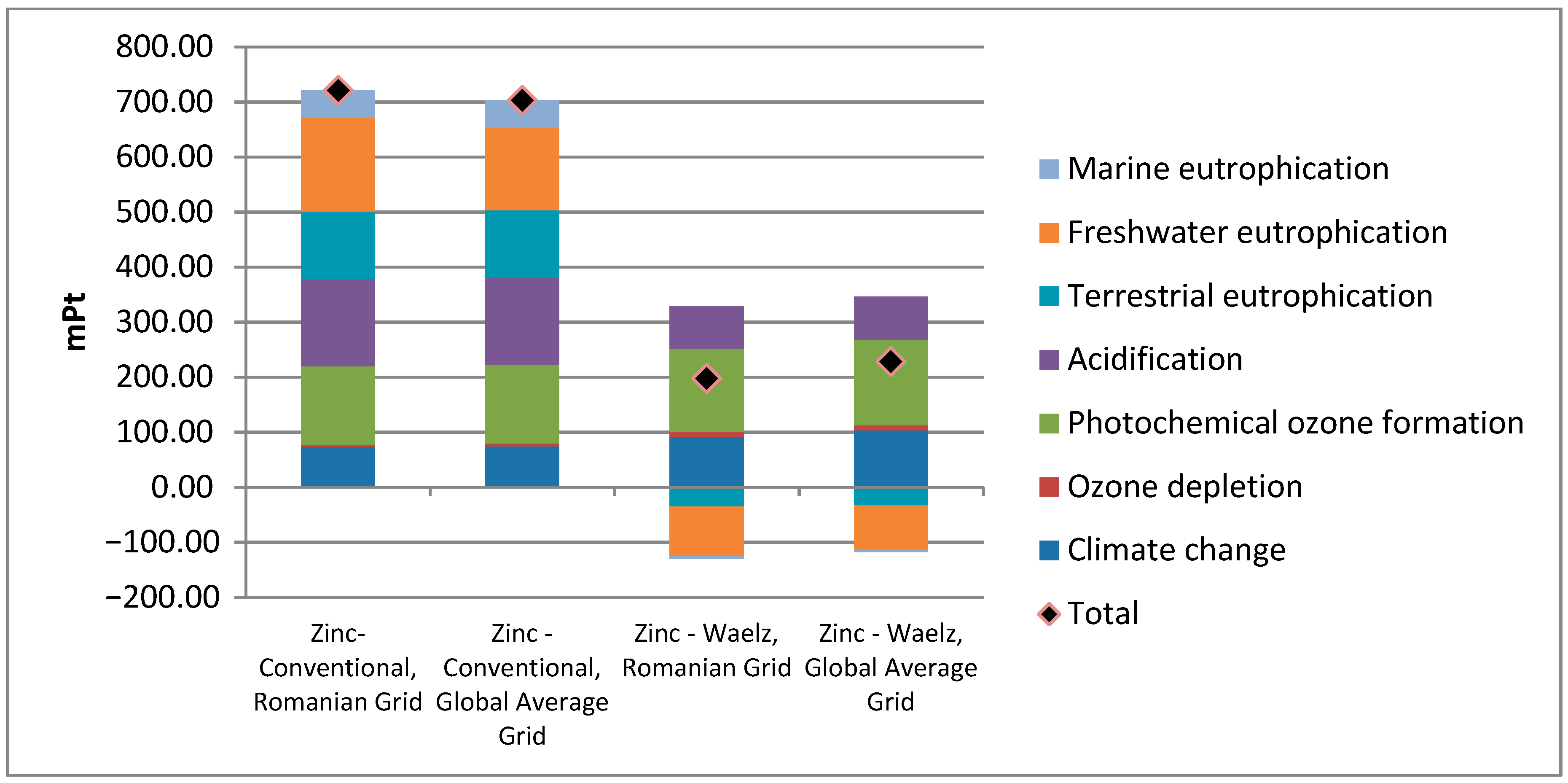
| Technology/Source | Percent Production |
|---|---|
| Hydro power | 39.52% |
| Natural gas | 24.30% |
| Coal | 36.18% |
| Impact Category | Unit | Zinc—Conventional | Zinc—Oxide |
|---|---|---|---|
| Climate change | kg CO2 eq | 7681.0280 | 11,005.4500 |
| Ozone depletion | kg CFC-11 eq | 0.0009 | 0.0016 |
| Photochemical ozone formation | kg NMVOC eq | 96.7283 | 104.8089 |
| Acidification | molc H+ eq | 134.1788 | 66.9742 |
| Terrestrial eutrophication | molc N eq | 298.9671 | −78.6908 |
| Freshwater eutrophication | kg P eq | 16.7063 | −8.0207 |
| Marine eutrophication | kg N eq | 22.9073 | −1.8510 |
| Impact Category | Unit | Zinc—Conventional | Zinc—Oxide |
|---|---|---|---|
| Total | mPt | 721.267 | 228.779 |
| Climate change | mPt | 72.432 | 103.781 |
| Ozone depletion | mPt | 4.934 | 8.967 |
| Photochemical ozone formation | mPt | 142.359 | 154.251 |
| Acidification | mPt | 159.460 | 79.593 |
| Terrestrial eutrophication | mPt | 121.537 | −31.990 |
| Freshwater eutrophication | mPt | 170.307 | −81.765 |
| Marine eutrophication | mPt | 50.238 | −4.059 |
| Impact Category | Zinc—Conventional, Romanian Grid | Zinc—Conventional, Global Average Grid | Difference | Zinc—Waelz, Romanian Grid | Zinc—Waelz, Global Average Grid | Difference |
|---|---|---|---|---|---|---|
| Climate change | 72.43 | 74.34 | 1.91 | 91.30 | 103.78 | 12.48 |
| Ozone depletion | 4.93 | 5.06 | 0.12 | 9.18 | 8.97 | −0.22 |
| Photochemical ozone formation | 142.36 | 143.73 | 1.37 | 151.51 | 154.25 | 2.74 |
| Acidification | 159.46 | 156.96 | −2.50 | 76.60 | 79.59 | 2.99 |
| Terrestrial eutrophication | 121.54 | 123.29 | 1.75 | −35.29 | −31.99 | 3.30 |
| Freshwater eutrophication | 170.31 | 149.81 | −20.50 | −89.26 | −81.76 | 7.49 |
| Marine eutrophication | 50.24 | 50.17 | −0.07 | −5.93 | −4.06 | 1.87 |
| Total | 721.27 | 703.35 | −17.91 | 198.11 | 228.78 | 30.67 |
Publisher’s Note: MDPI stays neutral with regard to jurisdictional claims in published maps and institutional affiliations. |
© 2021 by the authors. Licensee MDPI, Basel, Switzerland. This article is an open access article distributed under the terms and conditions of the Creative Commons Attribution (CC BY) license (http://creativecommons.org/licenses/by/4.0/).
Share and Cite
Muica, V.-T.; Ozunu, A.; Török, Z. Comparative Life Cycle Impact Assessment between the Productions of Zinc from Conventional Concentrates versus Waelz Oxides Obtained from Slags. Sustainability 2021, 13, 580. https://doi.org/10.3390/su13020580
Muica V-T, Ozunu A, Török Z. Comparative Life Cycle Impact Assessment between the Productions of Zinc from Conventional Concentrates versus Waelz Oxides Obtained from Slags. Sustainability. 2021; 13(2):580. https://doi.org/10.3390/su13020580
Chicago/Turabian StyleMuica, Voicu-Teodor, Alexandru Ozunu, and Zoltàn Török. 2021. "Comparative Life Cycle Impact Assessment between the Productions of Zinc from Conventional Concentrates versus Waelz Oxides Obtained from Slags" Sustainability 13, no. 2: 580. https://doi.org/10.3390/su13020580
APA StyleMuica, V.-T., Ozunu, A., & Török, Z. (2021). Comparative Life Cycle Impact Assessment between the Productions of Zinc from Conventional Concentrates versus Waelz Oxides Obtained from Slags. Sustainability, 13(2), 580. https://doi.org/10.3390/su13020580






